|
|
Updated as per James P. Tuttle's The Hawk Moths of North America, July 30, 2019
Updated as per BAMONA, formerly USGS, July 30, 2019
Dedicated to James Kreamier (Smerinthus ophthalmica, Long Creek, July 27, 209); July 30 2019
|
Grant County, Oregon
Sphingidae
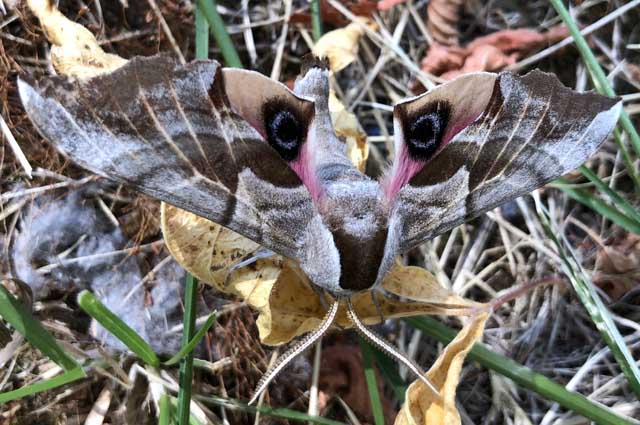
Smerinthus ophthalmica male, Long Creek, Grant County, Oregon,
July 27, 2019, courtesy of James Kreamier.
This page is dedicated to James Kreamier for providing the images of Smerinthus ophthalmica above and below. The strongly curved abdomen
is a valid indicator this one is a male.
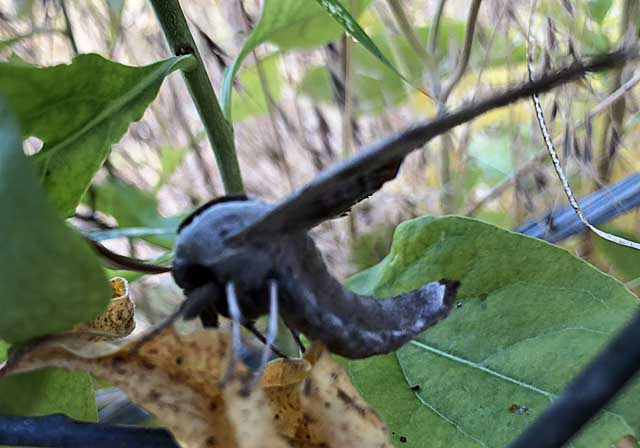
Smerinthus ophthalmica male, Long Creek, Grant County, Oregon,
July 27, 2019, courtesy of James Kreamier.
Twenty-two Sphingidae species are listed for Oregon on BAMONA as of July 30, 2019. Not all of the species are reported or anticipated in Grant County.
It is hoped that this checklist, with the thumbnails and notes, will help you quickly identify the moths you have encountered.
A "WO" after the species name indicates that I have no confirmed reports of this species in Grant County, but I
(William Oehlke) expect that this moth is present. A USGS (now BAMONA) indicates the
moth is reported on the USGS website and/or in Moths of Western North America, #2. Distribution of Sphingidae of Western North America, revised,
an excellent little booklet available through Paul Opler.
Please help me develop this list with improved, documented accuracy by sending sightings (species, date, location), preferably with an
image, via email to
Bill Oehlke.
Visit Similar checklists for all US states, all Canadian provinces, Mexico and all Central American and South American Countries.
Visit North American Catocala: Underwing moths.
Sphinginae subfamily
Sphingini tribe:
Proserpinus lucidus Pacific green sphinx
Hemaris thetis
 |
This species is not reported but may be present. Larvae feed on tomatoes and go
by the common name of "Tomato Hornworms". |
 |
Although not reported from Grant County, I suspect it is present.
I only see them occasionally on P.E.I. despite visiting lights frequently. |
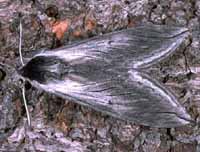 | The upperside of the forewing is dark grey to black with a
paler costa and pale area from the base to the wing's centre.
Prefered habitats include montane woodlands and mixed chaparral-type
vegetation. |
 |
Sphinx vashti
BAMONA, the Snowberry Sphinx
The upperside of the forewing has a narrow black subterminal line
bordered by a white inverted V-shaped line on the outside, and a
black line running inwards from the apex of the wing.
It is most often found in montane woodlands and along streamcourses. |
Smerinthini Tribe:
 |
Pachysphinx modesta
WO,
the Modest Sphinx or Poplar Sphinx,
This large poplar/willow feeder is not reported in Grant County but should be present.
They are a heavy bodied species.
|
 |
This one is quite similar to Pachysphinx modesta, with modesta being smaller and darker.
They are not reported in Grant County but should be present.
|
 |
The grey-blue eyespot of the hindwing gives this species its name.
Larvae feed on birches, willows, cherries and oaks.
The outer edge of the forewings is quite scalloped. |
 |
This small species is probably widespread and common. This species ranges across North America.
The hindwings have a small blue eyespot ringed with black on a yellow background.
|
 |
If you have willows and poplars nearby, you've probably got populations of
the Cerisyi's Sphinx. The hindwings are quite striking. |
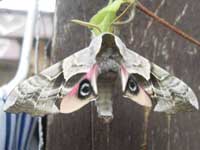 | Larvae feed on poplars, aspen and willows.
Note different shape of double arced forewing pm line compared to the straighter pm line of cerisyi, directly above.
S. ophthalmica has smoother scalloping of the fw outer margin. Possibly ophthamlmica repolaces cerisyi in Grant County.
|
Smerinthus opthalmica, Long Creek, July 27, 2019, James Kreamier
Macroglossinae subfamily
Dilophonotini tribe
 |
Hemaris diffinis USGS, the Snowberry Clearwing or Bumblebee Moth
This species is reported from Umatilla, and this day flying moth
is widely distributed in Oregon. It is probably Hemaris thetis that flies in Oregon. |
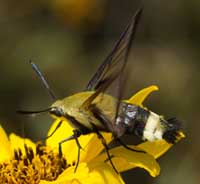 |
Hemaris thetis BAMONA, the Thetis Clearwing or Bee Hawk Moth,
The moth flies along forest edges and in meadows, gardens and
brushy fields. Day-flying adults nectar at lantana, dwarf bush honeysuckle,
snowberry, orange hawkweed, thistles, lilac, Canada violet, etc.
|
Macroglossini tribe
 |
Hyles gallii WO,
the Bedstraw Hawk Moth or Gallium Sphinx
This species is not officially reported from Grant County, but if
you have Gallium or Epilobium, you might have
populations of this species, but it is doubtful. |
 |
Hyles lineata BAMONA, the White-lined Sphinx
It can be seen flying during the day,
into the evening and also at night.
The highly variable larvae are often found in people's gardens. |
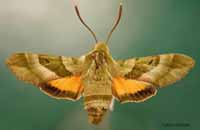 |
This species is reported from Grant County, this day flier,
April-June, prefering oak woodland and pine-oak woodland in foothills,
is probably present. Moths nectar at a variety of flowers in the afternoon.
|
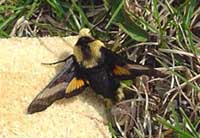 |
This day flier is not officially reported from Grant County, but it
may be present in meadows near coniferous forests. |
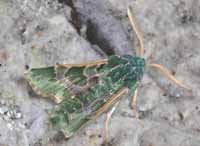 |
Proserpinus lucidus BAMONA, the Pacific Green
Sphinx Moth or Bear SphinxThis species
is recorded in Grant County.
It tends to be an early spring flier, on the wing in the early
evening. It comes to lights at night. |
|
|
Use your browser "Back" button to return to the previous page.
This page is brought to you by Bill Oehlke and the
WLSS. Pages are on space rented from Bizland. If you would like to become a "Patron of the Sphingidae Site", contact Bill.
Please send sightings/images to Bill. I will do my best to respond to requests for identification help.
Enjoy some of nature's wonderments: Saturniidae cocoons.
Cocoons of the giant silkmoths may be purchased in the fall and winter. Big and beautiful giant silk moths will emerge in spring/summer.
Read Actias luna rearing article. Additional online help available.
This website has been created and is maintained by Bill Oehlke without government or institutional financial assistance. All expenses, ie., text reference
support material, webspace rental from Bizland, computer repairs/replacements, backups systems, software for image adjustments (Adobe Photoshop; L-View),
ftp software, anti-virus protection, scanner, etc. are my own.
I very much appreciate all the many images that have been sent to me, or of which I have been granted permission to copy and post from other websites.
All images on this site remain the property of respective photographers.
If you would like to contribute to the maintenance of this website by sending a contribution to
Bill Oehlke
Box 476
155 Peardon Road
Montague, Prince Edward Island, C0A1R0
Canada
your donation would be much appreciated and would be used for
1) paying for webspace rental;
2) paying for computer maintenance and software upgrades;
3) purchases of additional text reference material (journals and books) in anticipation of expanding the site to a worldwide Sphingidae site;
4) helping to pay my daughter's tuition (now completed, spring 2013); with anything left over going to humanitarian aid.
If you are mailing a check from USA, please use $0.85 postage ($1.25 is 2019 rate). Donations can also be made through Paypal via the button below.


